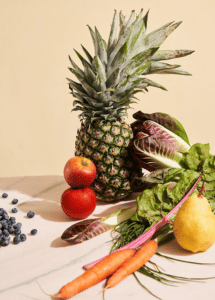EQ Microbiome Primer

 The human microbiome has a unique and delicate balance with trillions of microbial cells, each responsible for the functioning of our internal ecosystem. Microbial cells actually outnumber human cells by 10 times, and 95% of the human microbiome occurs in the gut! [1] With emerging research on the root cause of various ailments, illnesses, and disease, it is increasingly agreed upon that our health is closely related to the health of our gut microbiome. In this EQ Microbiome Primer, we’ll introduce strategies to help keep your body’s microbial environment healthy and thriving!
The human microbiome has a unique and delicate balance with trillions of microbial cells, each responsible for the functioning of our internal ecosystem. Microbial cells actually outnumber human cells by 10 times, and 95% of the human microbiome occurs in the gut! [1] With emerging research on the root cause of various ailments, illnesses, and disease, it is increasingly agreed upon that our health is closely related to the health of our gut microbiome. In this EQ Microbiome Primer, we’ll introduce strategies to help keep your body’s microbial environment healthy and thriving!
STEP 1: Assess Your Current Microbiome Health
Establish a baseline and understand where your microbiome health is currently at by taking our Microbiome Quiz.
STEP 2: Understand what affects your microbiome health
Everyone’s body is completely unique, and this is no exception for our microbiome. Because the human microbiome is such a vast topic, check out our Science 101: Microbiome to deep dive into the science of how our microbiome works. As a quick review, here are some factors that influence your microbiome balance:
Food and Diet
 The food you eat fuels and feeds the microorganisms that keep your body functioning. If you imagine your body as a vehicle, the food we eat acts as the gas that fills and fuels our tank! Taking in fuel that’s incompatible with the vehicle can lead to mechanical dysfunction – or in the body’s case discomfort, sickness, and all kinds of disease. Click here for some delicious gut-healthy recipes.
The food you eat fuels and feeds the microorganisms that keep your body functioning. If you imagine your body as a vehicle, the food we eat acts as the gas that fills and fuels our tank! Taking in fuel that’s incompatible with the vehicle can lead to mechanical dysfunction – or in the body’s case discomfort, sickness, and all kinds of disease. Click here for some delicious gut-healthy recipes.
Antibiotic and drug intake
Antibiotics can be lifesaving medications and have the ability to wipe out bad bacteria. Unfortunately, like an uncontrolled forest fire, they can also wipe out good bacteria in the process. Consider this the next time you have to take antibiotics, and be sure to support your body with gut-nourishing foods and supplements.
Stress
When it comes to the microbiome, stress has been associated with reduced diversity in the microbiome and increased gut barrier permeability. This means that there are fewer good bacteria to keep you going while also being more vulnerable to bad bacteria getting to places in your body that they shouldn’t be. This influences your stress response and can lead to a cycle that takes time to rebalance. For tips on stress management for your microbiome health, see step 6 below!
STEP 3: Add mindfulness to your diet
 One of the most powerful ways to influence your microbiome balance is being mindful of what you eat. It’s important to consider if certain foods are a culprit to symptoms like stomach aches, headaches, fatigue, and more – this can help you understand what adjustments to make for your body’s needs. After all, you are what you eat! However, everyone’s nutritional needs are different and it’s important to understand what works for you. For more insight into nutrition, check out our Science 101: Nutrition article and our Nutrition Primer for some tips. That being said, you can start practicing mindfulness within your diet and nutrition by evaluating what may or may not be working for you. Consider the following questions:
One of the most powerful ways to influence your microbiome balance is being mindful of what you eat. It’s important to consider if certain foods are a culprit to symptoms like stomach aches, headaches, fatigue, and more – this can help you understand what adjustments to make for your body’s needs. After all, you are what you eat! However, everyone’s nutritional needs are different and it’s important to understand what works for you. For more insight into nutrition, check out our Science 101: Nutrition article and our Nutrition Primer for some tips. That being said, you can start practicing mindfulness within your diet and nutrition by evaluating what may or may not be working for you. Consider the following questions:
- How do I feel after eating? Energized or tired?
- Was the meal satiating? Did I feel full?
- What kinds of foods am I craving?
- What foods do I love that love my body back?
For journaling and tracking tips and how to set up your own daily logs and notes, check out this resource by the GastroIntestinal Society. You can also check out Ate Food Journal, which is a user-friendly app that serves as a food journal (not a calorie counter!) Ate Food Journal focuses on helping you eat more mindfully and understand why and how you feel after eating certain foods.
STEP 4: Rebalance your gut
Rebalancing your gut with probiotics and prebiotics can have a positive impact on your digestive health and provide the support your body needs. This can look like taking supplements or being mindful of foods that are naturally rich in probiotics and prebiotics. – let’s take a look at the differences between the two:
Probiotics – Gut Guardians
Probiotics are good bacteria that function as defenders of your gut to support immune health and can improve your gut health by helping you digest food and absorb nutrients. Here are some ways to incorporate more probiotics into your routine:
- Fermented Food Fiesta: Incorporate fermented foods into your diet, such as yogurt, kefir, sauerkraut, kimchi, miso, and kombucha. These foods contain live beneficial bacteria that can contribute to a healthier gut.
- Diverse Diet Delights: Consume a wide variety of plant-based foods such as fruits, vegetables, whole grains, legumes, nuts, and seeds. Each type of plant provides different fibers that feed various beneficial microbes in your gut.
- Probiotic Parfait: Layer yogurt with fresh fruit and a sprinkle of granola. The next time you’re at the grocery store, grab a tub of yogurt, preferably the kind with “live and active cultures” on the label.
If you’re new to probiotics and don’t know where to start, try out our Daily Women’s Microbiome Defense. Our team will be here to provide any support and answer any questions as you get started!
 Prebiotics – Belly Boosters
Prebiotics – Belly Boosters
Prebiotics are special types of dietary fibers that act as food for beneficial bacteria in your gut, boosting them to thrive and support your overall health – they are like welcome mats in your digestive system, rolling out the red carpet for the probiotic gut guardians!
- Prebiotic Parade: Consume prebiotic-rich foods like garlic, onions, leeks, asparagus, legumes, cocoa, and bananas.
- Whole Grain Galore: Choose whole grains over refined grains. Whole grains like oats, quinoa, brown rice, and whole wheat contain fibers that support a healthy gut.
- Salad Serenade: Make your salads sing with prebiotics! Toss in some jicama, chicory root, or raw garlic for an unexpected flavor burst.
For a diverse boost in your diet, try out our Daily Nutri-Greens. This greens powder supplement includes a prebiotic and probiotic blend to fill in the gaps in your nutrition and support your overall gut health!
STEP 5: Water your microflora and stay hydrated!
It’s nothing new to us that drinking water is essential for our health. When it comes to our microbiome, proper hydration is essential for optimal functioning such as improving digestion, regulating bowel movements, producing mucus that protects the gut barrier, transporting nutrients or waste through the body, and more!
 Tips for staying hydrated
Tips for staying hydrated
- Choose a drinking vessel you love: Finding a water bottle that is easy to carry around with you everywhere can increase your chances of picking it up for a drink. Consider preferences like insulated or double walls if you like cold water and a wide mouth opening or a straw if you prefer to take big gulps or slowly sip it!
- Consider your lifestyle: The amount of daily water intake for each individual can vary on factors such as your physical activity levels, the climate you live in, as well as your overall health. If you work out and sweat often, live in higher altitudes, or have any health problems your daily water intake may be more than the average! Check out this science-based hydration calculator to determine how much water you should be drinking daily.
- Set reminders to build better habits: It can be easy to go through your daily routine and forget to hydrate, so an occasional notification to hydrate can make a big difference. If your daily life is already bombarded with notifications, try habit-stacking! For example, every time you pick up your phone, take a quick sip of water – just pick a recurring existing habit that you can pair your hydration with.
STEP 6: Manage your stress
 To learn more about the general science of stress and tips on how to manage your stress, check out our Science 101: Stress article and Stress Primer! Stress can directly impact your microbiome and digestive system as well, so here are two great to decrease your stress and support your gut:
To learn more about the general science of stress and tips on how to manage your stress, check out our Science 101: Stress article and Stress Primer! Stress can directly impact your microbiome and digestive system as well, so here are two great to decrease your stress and support your gut:
- Exercise and Movement – An increasing amount of research has shown trends between exercise and gut health, and how exercise can help to regulate your digestion and bowel function. [7] Check out this video to learn about the kinds of movement that support your gut health.
- Breathing Exercises and Meditation: The vagus nerve that connects the brain to the gastrointestinal system plays a major role in gut health; the vagus nerve can be stimulated by slow breathing in the diaphragm to turn on the parasympathetic nervous system, aka our rest and digest state! Try these guided diaphragmatic breathing exercises or check out this guided Gentle Meditation that focuses on your gut health and guided imagery for relaxation.
STEP 7: Look outside the box
The gut makes up 95% of the microbiome, but how about the other 5%? There are microbiome ecosystems in various parts of our inner world, including the gut, vagina, oral cavity, and skin – here are some tips for supporting your entire body’s ecosystems:
Vagina
Studies profiling the bacteria in the human microbiome found that Lactobacillus, a species of beneficial bacteria, made up an average of 72.85% of the core vaginal microbiota in healthy-state vaginas. [9] An imbalance of the vaginal microbiome can lead to vaginal infections and discomfort.
Practice Safe Sex
The use of barrier methods such as condoms can help protect against sexually transmitted infections (STIs) that can disrupt the natural balance of the vaginal microbiome. Regular STI testing and practicing safe sex are key aspects of maintaining vaginal health.
Proper Vaginal Hygiene
Good hygiene is important, however, it’s equally important not to overdo it! Avoid using harsh soaps, douches, or scented products in the vaginal area, as these can disrupt the natural balance of the microbiome and increase the risk of infections.
Probiotic Support
Every woman’s vaginal microbiome is different, however, supplementing with common strains of probiotics may prevent the invasion of bad bacteria and pathogens. Consider supporting your vaginal health with probiotics that focus on Lactobacillus strains. EQ’s Daily Women’s Microbiome Defense provides 5 probiotic strains that have been studied for women’s health as well as Pacran, a full spectrum cranberry ingredient that has been clinically studied for urinary tract health.
Oral
As the second largest microbial habitat, the health of your oral cavity can have local and widespread effects on the body – from dental issues to systemic diseases. [10]
- Dental hygiene: Brushing your teeth doesn’t just keep your teeth healthy. Dental hygiene directly influences the oral microbiome, so be sure to use flossers or tongue scrapers as well to remove bad bacteria.
- Keep a hydrated mouth – dry mouth can negatively affect your oral microbiome! Note that things like smoking can dry out the oral cavity and disrupt saliva flow.
- Avoid anti-bacterial mouthwash – remember that wiping out bad bacteria can also wipe out the good with antibacterial options! Try looking for mouthwashes with prebiotics.
Skin
The skin’s microbial ecosystem is a bustling community of microorganisms that live on the surface of our skin to protect against pathogens and maintain the skin’s pH level, moisture balance, and oil production.
- Stick to regular soap and water: The overuse of antibacterial soaps can disrupt the balance of your skin microbiome by killing harmful and beneficial bacteria.
- Moisturize: Choose a moisturizer suitable for your skin type – proper hydration maintains a healthy skin barrier and supports the growth of beneficial microorganisms.
- Avoid hot water: Hot water strips your skin of natural oils and can disrupt your microbiome, so use lukewarm water when you bathe.
Step 8: Know when to seek professional guidance
 There are many remedies readily available for nourishing your body with the fuel it needs to run smoothly, but sometimes chronic issues may need more support than just eating more vegetables. If you have concerns about your microbiome health that seem significant and/or unresponsive to lifestyle adjustments, it may be time to speak to a licensed healthcare provider. Here are some options to consider when initiating that conversation:
There are many remedies readily available for nourishing your body with the fuel it needs to run smoothly, but sometimes chronic issues may need more support than just eating more vegetables. If you have concerns about your microbiome health that seem significant and/or unresponsive to lifestyle adjustments, it may be time to speak to a licensed healthcare provider. Here are some options to consider when initiating that conversation:
- Write down your symptoms and any noticeable patterns to share with your doctor.
- Know your goals before your appointment.
- Request a blood test for food allergies, sensitivities, and nutritional deficiencies.
- Seek a referral to a nutrition specialist.
The Takeaway…
The world of your microbiome is a fascinating and intricate ecosystem that holds the key to our overall well-being. By understanding its importance and implementing some of these tips, you can take proactive steps to support a happy and harmonious gut. A healthier gut means a healthier you, so keep nourishing your body and the microorganisms that keep your body running smoothly!
Resources:
- Hajjo R, Sabbah DA, Al Bawab AQ. Unlocking the Potential of the Human Microbiome for Identifying Disease Diagnostic Biomarkers. Diagnostics. 2022;12(7):1742. doi:10.3390/diagnostics12071742
- Gagliardi A, Totino V, Cacciotti F, et al. Rebuilding the Gut Microbiota Ecosystem. Int J Environ Res Public Health. 2018;15(8):1679. doi:10.3390/ijerph15081679
- Almeida C, Oliveira R, Soares R, Barata P. Influence of gut microbiota dysbiosis on brain function: a systematic review. Porto Biomed J. 2020;5(2):1-8. doi:10.1097/j.pbj.0000000000000059
- Boolani A, Gallivan KM, Ondrak KS, et al. Trait Energy and Fatigue May Be Connected to Gut Bacteria among Young Physically Active Adults: An Exploratory Study. Nutrients. 2022;14(3):466. doi:10.3390/nu14030466
- Mahmud MdR, Akter S, Tamanna SK, et al. Impact of gut microbiome on skin health: gut-skin axis observed through the lenses of therapeutics and skin diseases. Gut Microbes. 14(1):2096995. doi:10.1080/19490976.2022.2096995
- Ousey J, Boktor JC, Mazmanian SK. Gut microbiota suppress feeding induced by palatable foods. Curr Biol. 2023;33(1):147-157.e7. doi:10.1016/j.cub.2022.10.066
- Deng R, Wang M, Song Y, Shi Y. A Bibliometric Analysis on the Research Trend of Exercise and the Gut Microbiome. Microorganisms. 2023;11(4):903. doi:10.3390/microorganisms11040903
- Williams NT. Probiotics. Am J Health Syst Pharm. 2010;67(6):449-458. doi:10.2146/ajhp090168
- Chee WJY, Chew SY, Than LTL. Vaginal microbiota and the potential of Lactobacillus derivatives in maintaining vaginal health. Microb Cell Factories. 2020;19:203. doi:10.1186/s12934-020-01464-4